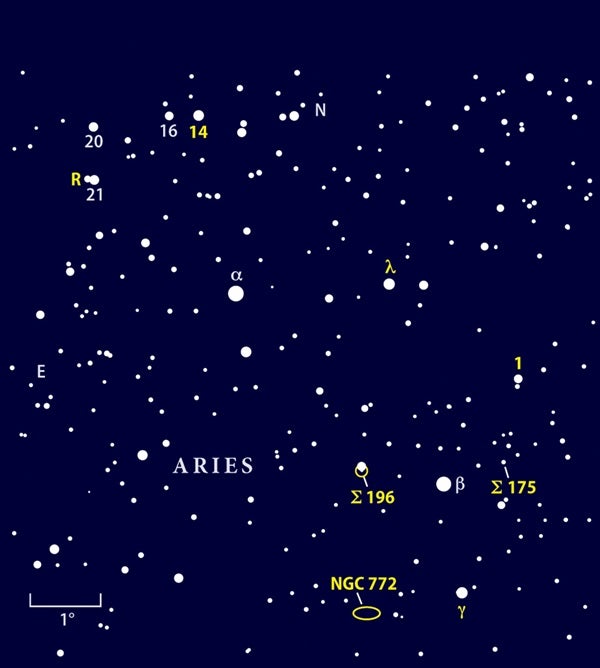The focus of that column was the area around the naked-eye stars Hamal (Alpha [α] Arietis), Sheratan (Beta [β] Arietis), and Mesarthim (Gamma [γ] Arietis). Mesarthim is one of the loveliest double stars in the entire night sky. It’s a striking twin system, nearly identical in brightness (magnitudes 4.5 and 4.6) and color (both are pure-white stars of spectral classes A1 and B9). Separated by 7.4″, the two are easily split with a common 2.4-inch refractor and a magnification around 50x. As we peer into the eyepiece, they seem to stare back like the gleaming eyes of a celestial cat (or car headlights, if you’re a cat-hater).
More of a challenge is 1 Arietis, 3° north of Mesarthim. To open the 2.9″ gap separating its magnitude 6.3 and 7.2 components, you’ll need steady skies and a magnification of 100x or more. Just over a degree south (and 1° west-northwest of Sheratan) is the faint pair Σ 175, one of over 3,100 double stars cataloged by the German-Russian astronomer Friedrich Georg Wilhelm von Struve in the 1830s. These magnitude 9.0 and 9.4 stars have widened from 6.0″ in 1783 to a current 28.1″ and are likely an optical pair (meaning not physically related).
A return to bright, easily resolved double stars brings us to Lambda (λ) Arietis, found 2½° west of Hamal. The same 50x magnification that split Mesarthim will readily bridge the 37″ space between Lambda’s magnitude 4.8 and 6.7 components. Back at Hamal, we hop 2½° northward to the final destination in that Deep Sky Monthly article, the wide triple 14 Arietis. The 5th-magnitude primary star has two 8th-magnitude companions, one 93″ to the north-northeast and one 105″ to the west.
For you fans of faint fuzzies, I’ll throw in the Fiddlehead Galaxy (NGC 772), which glows at magnitude 10.3. A challenge for small scopes and even larger ones under moderately light-polluted skies, it appears as a faint, slightly elliptical smudge with a bright nucleus. You’ll find it in an area 1½° east and slightly south of Mesarthim.
Finally, something for you variable star observers. Just 5′ east of 6th-magnitude 21 Arietis — found by star-hopping from 14 Arietis, past 16 Arietis to 20 Arietis, and then dropping ¾° south — is the Mira-type variable R Arietis. It varies from magnitude 7 or 8 at maximum brightness to 13 or 14 at minimum over an average cycle of six months.
Based on past behavior, the American Association of Variable Star Observers (AAVSO) predicts that, as this issue goes to press, R Arietis should be on the rise to an early December maximum. Should you wish to monitor this activity, you can obtain free printable charts complete with notated magnitudes of nearby comparison stars at the AAVSO website (www.aavso.org).
Under “Observing” on the main page, scroll down to “Variable Star Charts” and across to “Variable Star Plotter” (VSP). At the VSP page, type in “R Ari” in the name/designation box, and select “A” as your chart scale option. Press “Plot Chart” to create a 15°-wide finder chart (north up) that includes Hamal, Sheratan, and Mesarthim. Use the “B” scale option for a 3°-wide chart to help you monitor R Arietis in the months ahead.
Questions, comments, or suggestions? Email me at gchaple@hotmail.com. Next month: We crater-hop to “Mutus X.” Clear skies!











